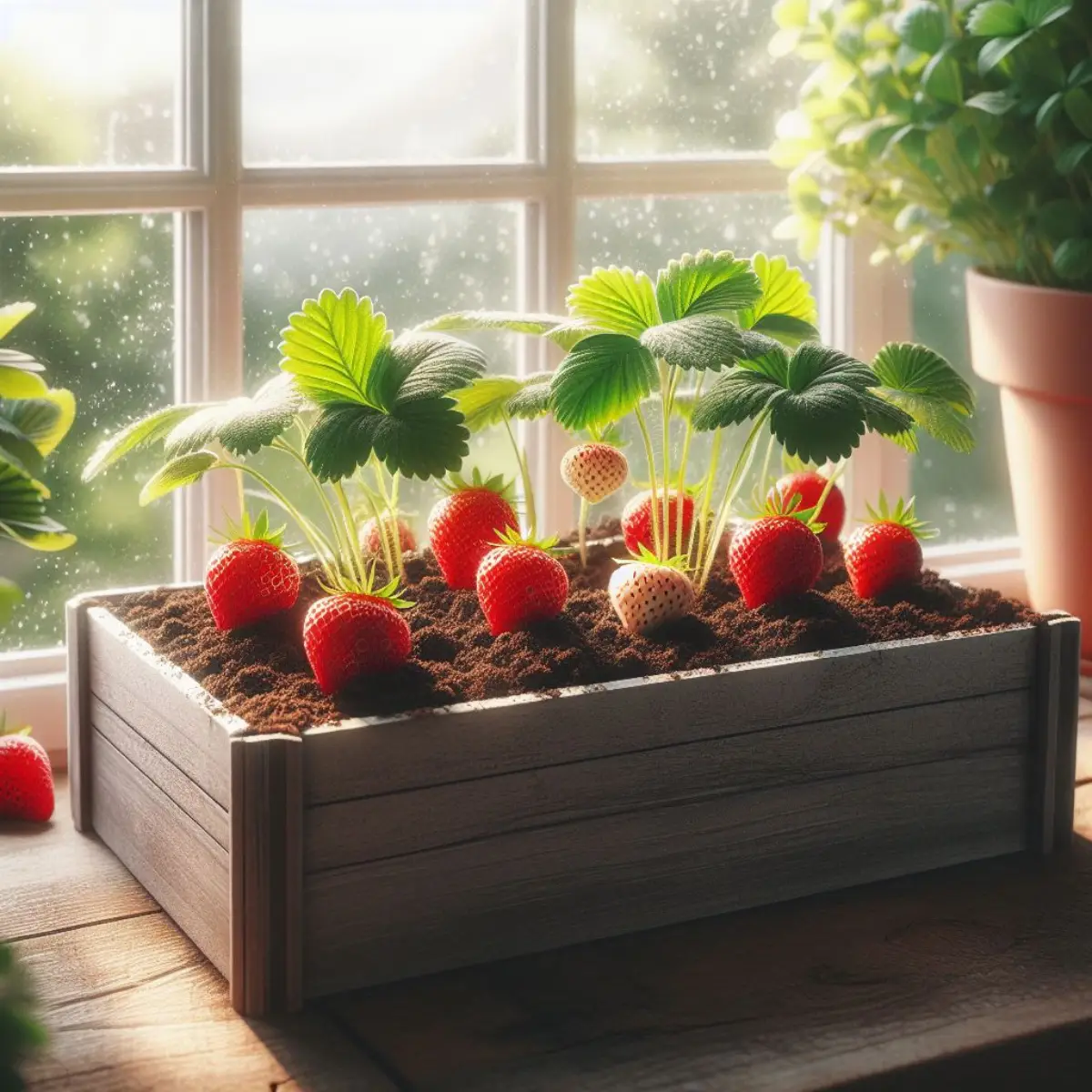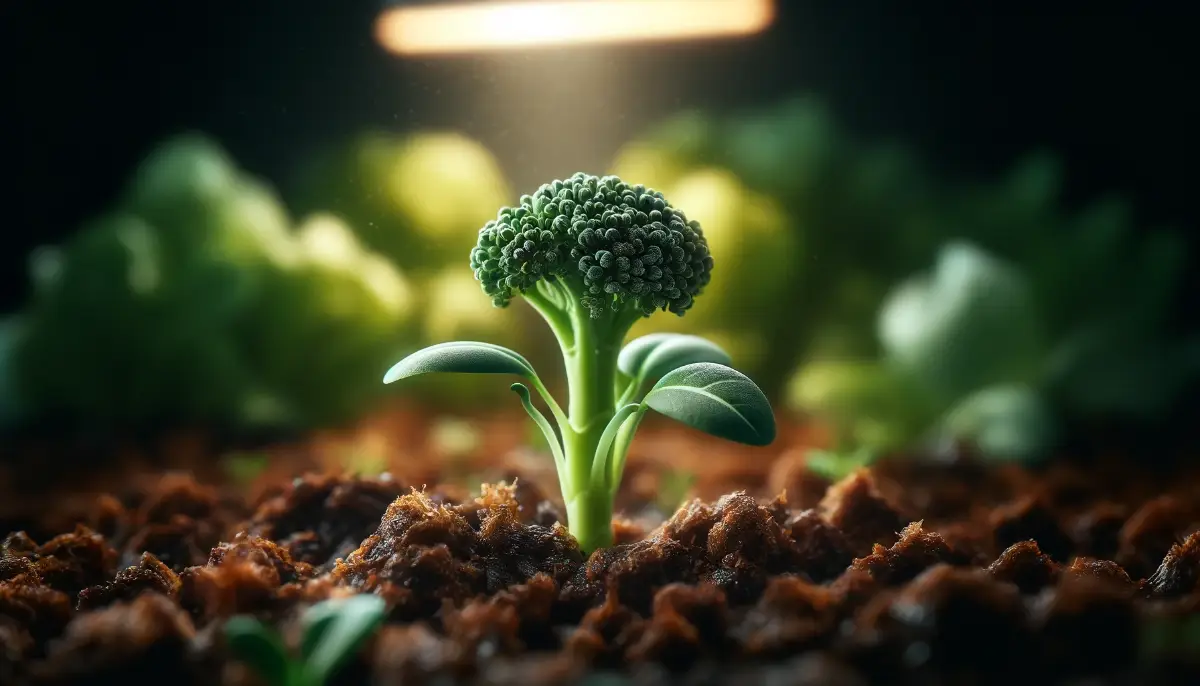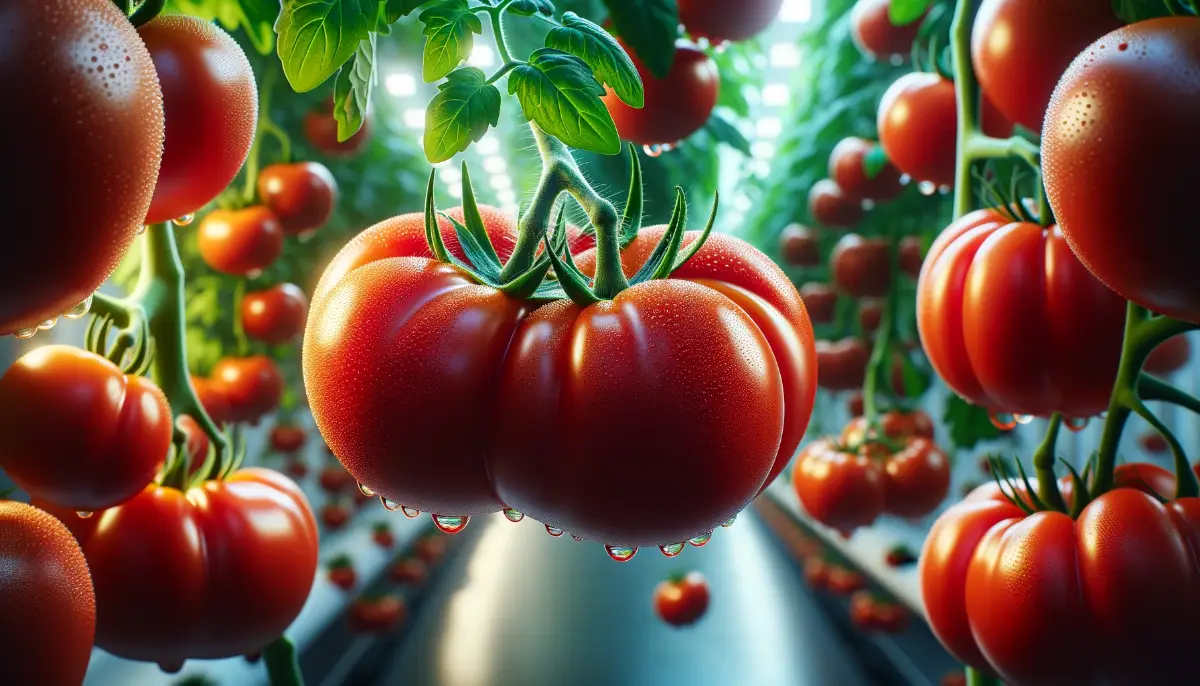Growing blueberries indoors is an enjoyable and rewarding endeavor that allows you to savor fresh, succulent berries right from your living room or kitchen.
This guide will introduce you to the essential aspects of indoor blueberry cultivation, including choosing the right variety, preparing the perfect environment, and understanding the specific care requirements these delightful plants need.
With the right setup and some patience, you can transform even a small space into a productive mini-blueberry farm, ensuring a year-round supply of this superfood, renowned for its health benefits and delicious flavor.
Selecting the Right Variety
When planning to grow blueberries indoors, choosing the correct variety is crucial. The variety must not only be suited to your climate and space but also to the indoor environment’s specific conditions.
Dwarf Varieties
- Top Hat: Ideal for container gardening, Top Hat is a dwarf variety that thrives in small spaces and is self-pollinating, which means it doesn’t require another plant to produce fruit.
- Sunshine Blue: This variety is particularly well-suited for warmer climates or indoor settings because it requires fewer chill hours compared to other types. It’s also self-pollinating and can grow up to 36 inches tall, making it a substantial yet manageable bush for indoor conditions.
- Northsky and Northblue: Both are cold-hardy, lowbush varieties, which are perfect for container growth. Northsky remains relatively small, while Northblue can reach up to 48 inches and is known for its larger harvests.
Considerations for Indoor Growth
- Chill Hours: Understanding the chill hours (the number of hours below 45 degrees Fahrenheit / 7°C a plant needs to enter dormancy) is essential. Varieties like Sunshine Blue require as few as 150 chill hours, making them more adaptable to indoor environments where controlling temperature precisely can be challenging.
- Self-Pollination: While some varieties are self-pollinating, having more than one plant can significantly increase yields. For those varieties that require cross-pollination, consider space for at least two plants.
Tips for Selection
- Consult Local Experts: Visit local nurseries or contact agricultural extensions to find out which varieties grow best in your area.
- Research Specific Needs: Each variety may have unique requirements in terms of light, water, and soil pH. Make sure the variety you choose matches your ability to meet these needs within an indoor setting.
Selecting the right variety of blueberry is the first step toward a successful indoor gardening experience. With the right variety, you can enjoy bountiful harvests of fresh, delicious blueberries directly from your home.
Preparing the Indoor Environment
Creating the right environment is key to successfully growing blueberries indoors. Here are the essential factors to consider to ensure your blueberries thrive.
Adequate Lighting
- Sunlight Exposure: Blueberries require about 6-8 hours of direct sunlight daily. South-facing windows are ideal to maximize natural sunlight exposure.
- Grow Lights: In areas where natural sunlight is insufficient, especially during winter months, using grow lights can provide the necessary light spectrum. LED grow lights are recommended for their efficiency and effectiveness in supporting plant growth.
Proper Soil Conditions
- Soil pH: Blueberries need acidic soil with a pH between 4.5 and 5.5. You can either purchase a pre-mixed soil designed for acid-loving plants or create your own mix using equal parts peat moss, compost, and perlite.
- Drainage: Ensure the container has adequate drainage to prevent waterlogging. Adding a layer of small pebbles at the bottom of the pot can help improve drainage and prevent root rot.
Humidity and Air Circulation
- Humidity Levels: Blueberries thrive in moderate humidity. If your indoor air is too dry, consider using a humidifier or placing a water tray near the heating system to increase air moisture.
- Air Circulation: Good air circulation is crucial to prevent fungal diseases. Ensure there is enough space between your plants and use a small fan if needed to improve air flow around the plants.
Temperature Control
- Optimal Temperatures: Blueberries require cooler temperatures during their dormant period and warmer temperatures during the growing season. The ideal temperature range is between 60-85°F/ 16-30°C during active growth and 32-45°F/ 0-7°C during dormancy.
- Seasonal Adjustments: Adjust the placement of your plants according to the season. For example, moving them away from cold drafts in winter and avoiding direct exposure to air conditioning vents in summer can help maintain the optimal temperature.
Container and Placement
- Container Size: Choose a container that is deep enough to accommodate the root system and allows for growth. Containers with a depth of 18-24 inches are generally suitable.
- Location: Place your blueberry plants where they can receive the most light and where temperature conditions are most stable. Avoid areas near heat sources or drafty windows.
Setting up the right indoor environment for blueberries involves careful consideration of light, soil, humidity, and temperature. By controlling these factors, you can maximize your blueberry plants’ health and productivity, ensuring a bountiful harvest right from your indoor garden.
Planting and Initial Care
Successfully planting and caring for blueberries indoors starts with the right preparation and an understanding of the plant’s initial requirements. Here’s a step-by-step guide to get your indoor blueberry garden started on the right foot.
Planting Your Blueberries
- Container Selection: Choose a container with sufficient depth and drainage holes to accommodate the blueberry bush’s root system. A depth of 18-24 inches is ideal.
- Soil Preparation: Fill the container with a specifically formulated acidic soil mix, ensuring a pH between 4.5 and 5.5. If creating your own mix, use equal parts peat moss, compost, and perlite to achieve the desired acidity.
- Planting Process: Plant the blueberries ensuring that the root ball is slightly below the rim of the container. This helps in watering and mulching. Space multiple plants at least 18 inches apart to allow for growth and air circulation.
Initial Watering
- Water Requirements: After planting, water your blueberries thoroughly to settle the soil around the roots. Continue to keep the soil moist but not waterlogged. The top inch of soil should feel damp to the touch before additional watering is needed.
- Monitoring Moisture Levels: Check the soil moisture regularly, as consistent moisture is crucial to prevent stress and promote healthy growth.
Fertilization
- Initial Feeding: Use an acidic fertilizer suitable for blueberries or an organic alternative like cottonseed meal or feather meal. During the first year, fertilize every few months as directed on the fertilizer package.
- Ongoing Nutrition: After the first year, you can reduce fertilization frequency but continue using light doses to support fruit production without promoting excessive leaf growth.
Mulching
- Purpose of Mulching: Mulch helps retain soil moisture, suppress weeds, and maintain soil temperature. Use pine bark mulch or pine needles, which add acidity to the soil as they decompose.
- Application: Apply a 2-3 inch layer of mulch around the base of the plant, avoiding direct contact with the stem to prevent rot.
By following these planting and initial care steps, your indoor blueberry bushes will be well-prepared to grow and eventually produce delicious blueberries.
Remember, the key to success is maintaining the right soil conditions, ensuring adequate moisture, and providing the necessary nutrients during the critical early stages of growth.
Watering Needs
Proper watering is crucial for the health and productivity of indoor blueberry bushes. Here are key guidelines to ensure your plants receive the right amount of water without becoming waterlogged or too dry.
Consistency is Key
- Maintaining Moisture: Blueberries require soil that is consistently moist. It’s important to water the plants regularly to maintain this moisture level without over-saturating the soil.
- Checking Soil Moisture: Use your finger to check the moisture level of the soil. The top inch should be slightly dry before you water again. This helps ensure that you’re not over-watering, which can lead to root rot.
Techniques for Watering
- Deep Watering: When you water, do so deeply and thoroughly to ensure the water reaches the entire root system. Allow the water to drain completely, as standing water can harm the plant.
- Frequency of Watering: The frequency of watering will depend on several factors, including the size of the container, the type of soil, and the indoor environment’s humidity and temperature. During warmer months or in dryer indoor conditions, you might need to water more frequently.
Environmental Considerations
- Humidity Levels: If your indoor environment is particularly dry, consider using a humidifier or placing a tray of water near your heating system to increase humidity, which can help reduce the frequency of watering.
- Seasonal Adjustments: Be aware of seasonal changes in your home’s environment, as heating systems in winter can dry out the air and soil more quickly, requiring more frequent watering.
Signs of Improper Watering
- Overwatering: Symptoms include yellowing leaves and a lack of new growth. If the soil feels soggy or smells musty, you might be overwatering.
- Underwatering: Look for drooping leaves and dry, brittle branches. If the soil is dry below the surface, the plant needs more water.
By monitoring and adjusting your watering practices based on these guidelines, you can create an optimal growing environment for your indoor blueberry bushes. Proper watering will promote healthy growth and abundant fruit production.
Organic Fertilization Schedule for Indoor Blueberries
Proper fertilization is crucial to the success of growing blueberries indoors, particularly when using organic methods. Here’s how to create an effective organic fertilization schedule to ensure your blueberry bushes thrive.
Understanding Organic Fertilizers
- Types of Organic Fertilizers: Organic options like cottonseed meal, feather meal, or a specially formulated organic berry fertilizer are excellent choices for blueberries. These fertilizers release nutrients slowly, providing a steady supply that supports growth without overwhelming the plants.
Initial Fertilization
- Upon Planting: Initially, mix a granular organic fertilizer into the soil before planting. This helps establish a nutrient-rich base that will support your blueberries as they begin to grow.
- First Year: During the first year of growth, apply an organic fertilizer every few months. Be sure to follow the instructions on the product label for proper application rates.
Regular Feeding Schedule
- Growing Season (Spring to Summer): Fertilize your blueberries once in early spring as new growth appears, and again in mid-summer to support fruit development. This helps the plants produce healthy, abundant berries.
- Application Method: Sprinkle the fertilizer evenly around the base of the plants, away from the stem, and water thoroughly to help incorporate the nutrients into the soil.
Special Considerations
- Soil pH Monitoring: Since blueberries require acidic soil, it’s important to monitor the pH regularly. Organic fertilizers can affect soil pH, so adjust your fertilization practices if the pH moves outside the ideal range of 4.5-5.5.
- Observing Plant Response: Pay attention to how your plants respond after each application. Signs of good health include vigorous growth and plentiful berry production. Adjust the fertilizer type or frequency if the plants show signs of distress, such as yellowing leaves or stunted growth.
Avoiding Over-Fertilization
- Signs of Over-Fertilization: Over-fertilizing can lead to excessive leaf growth at the expense of fruit production. If you notice lush green growth with few or no berries, consider reducing the amount of fertilizer.
- Balancing Nutrients: It’s also important to ensure a balance of nutrients. Organic fertilizers typically provide a balanced N-P-K ratio suitable for fruiting plants like blueberries but always confirm this by reading the product label.
Pollination and Pruning of Indoor Blueberries
Ensuring proper pollination and regular pruning are crucial steps in cultivating fruitful indoor blueberry bushes. Here’s a detailed guide on how to manage these aspects effectively.
Pollination
- Self-Pollinating Varieties: Many blueberry varieties are self-pollinating, but even these benefit from the presence of another plant of a different variety to enhance fruit yield.
- Manual Pollination: For indoor plants, especially in the absence of natural pollinators like bees, manual pollination becomes necessary. Use a small paintbrush or a cotton swab to gently transfer pollen from one flower to another. This mimics the natural action of bees and helps increase the chances of fruit setting.
- Cross-Pollination: If possible, grow more than one variety of blueberry to facilitate cross-pollination. This usually results in larger berries and higher yields. Ensure that the varieties selected bloom at the same time to make cross-pollination possible.
Pruning
- Timing: The best time to prune blueberry bushes is late winter or early spring before new growth starts. This allows you to see the structure of the plant clearly and make better pruning decisions.
- Objectives: The goals of pruning are to remove dead or diseased wood, thin out crowded areas to improve air circulation, and encourage the growth of vigorous new branches that will produce fruit the following season.
- Technique: When pruning, focus on cutting back older branches, which are less productive, to encourage new growth. Also, remove any low growth that touches the ground to prevent disease and make harvesting easier. Use clean, sharp pruning shears to make clean cuts.
Maintenance Pruning
- Ongoing Care: Throughout the growing season, look for and remove any small, weak branches that aren’t likely to produce well. This helps direct the plant’s energy towards more fruitful growth.
- Renewal Pruning: For older plants, consider more aggressive pruning to rejuvenate the bushes. Remove about a third of the oldest branches each year, which stimulates the growth of younger, more vigorous branches.
Proper pollination and regular pruning not only enhance the yield and quality of your blueberries but also contribute to the overall health of the plants, ensuring a bountiful harvest season after season.
Temperature and Seasonal Adjustments for Indoor Blueberries
Understanding and managing the temperature and seasonal adjustments is crucial for the successful indoor cultivation of blueberries, particularly because these plants have specific chill hour requirements to initiate dormancy and subsequent fruiting.
Importance of Cooler Temperatures
- Dormancy Requirements: Blueberries require a period of cooler temperatures to enter a dormant state, which is essential for the health of the plant and the development of buds that will produce fruit in the next season. This dormancy mimics the natural winter conditions that blueberries face in the wild.
- Varietal Differences: Different varieties of blueberries have varying requirements for chill hours. For example, the ‘Sunshine Blue’ variety needs fewer chill hours compared to more traditional types, making it more suitable for indoor environments where achieving lower temperatures can be challenging.
Achieving Indoor Cool Temperatures
- Strategic Placement: During the winter months, place blueberry plants in the coolest part of your home. Locations near windows that receive less direct sunlight or areas near glass doors where temperatures are lower can be ideal.
- Using Technology: If natural cool conditions are not achievable, consider using a refrigerator or a similar controlled environment to provide the necessary chill hours. This method requires careful monitoring to avoid excessively cold temperatures that could damage the plant.
- Temperature Fluctuations: Maintain a steady cool temperature during the dormancy period. Sudden changes in temperature can disrupt the dormancy cycle and affect fruit production. Ideally, keep indoor blueberries in temperatures ranging from 32-45°F/ 0-7°C during their dormant period.
Post-Dormancy Care
- Gradual Warming: Once the required chill hours are met, gradually expose the plants to warmer conditions to simulate the arrival of spring. This encourages the plants to exit dormancy and begin the flowering and fruiting processes.
- Monitoring Growth: After the dormancy period, closely monitor the plants for signs of new growth, which indicates that the plant is responding well to the changes in temperature and is ready for a productive season.
By carefully managing the temperature and making seasonal adjustments, indoor blueberry growers can successfully mimic the natural growth cycle of the plants, promoting healthy development and maximizing fruit production.
Harvesting and Storing Blueberries
Successfully harvesting and storing blueberries ensures you can enjoy their freshness and flavor long after the harvest. Here’s how to correctly pick and store your indoor-grown blueberries to maximize their shelf life and quality.
Harvesting Blueberries
- Timing is Crucial: Harvest time is critical for blueberries. They should be fully ripened on the bush before picking; this typically means waiting until they turn a uniform deep blue and detach easily from the plant with a light touch.
- Method of Picking: Gently roll the berries between your thumb and the finger and tug lightly. If the berry resists, it’s not ready to be picked. Harvesting too early can result in sour flavors.
- Regular Checks: Blueberries will not ripen all at once. Check your plants every couple of days and only pick the berries that are ready to ensure you get them at their peak ripeness.
Storing Fresh Blueberries
- Preparation for Storage: Do not wash the berries immediately after picking as moisture can cause them to spoil more quickly. Instead, remove any damaged or moldy berries and store the healthy ones dry.
- Refrigeration: Place the unwashed blueberries in a breathable container or a paper bag with ventilation holes before refrigerating. This can help maintain their freshness for up to a week.
- Long-Term Storage: For longer storage, blueberries can be frozen. Spread them out on a baking sheet in a single layer to freeze them individually. Once frozen, transfer them to a freezer bag or an airtight container. This prevents them from clumping together and makes it easy to use small amounts as needed.
Using Stored Blueberries
- Thawing: When ready to use, take out the desired amount of blueberries and wash them. Thaw them at room temperature or in the refrigerator depending on how quickly you need them.
- Usage Ideas: Frozen blueberries are excellent in smoothies, baking, or as toppings for cereals and yogurts, while fresh blueberries make great snacks or additions to salads and desserts.
FAQs on Growing and Caring for Blueberries Indoors
What are the best varieties of blueberries to grow indoors?
Dwarf and lowbush varieties like Top Hat, Northsky, and Sunshine Blue are ideal for indoor cultivation due to their compact size and lower chill hour requirements.
How much light do indoor blueberries need?
Blueberries require about 6-8 hours of direct sunlight per day. If natural light is insufficient, supplement with LED grow lights.
What type of soil is best for indoor blueberries?
Use acidic soil with a pH between 4.5 and 5.5. A mix of peat moss, compost, and perlite is often recommended to achieve the right acidity and drainage.
How often should I water my indoor blueberry plants?
Keep the soil consistently moist but not waterlogged. Water when the top inch of soil feels dry to the touch.
Do I need to prune indoor blueberry plants?
Yes, prune in late winter or early spring to remove dead or diseased branches, thin out crowded areas, and promote healthy new growth.
How do I pollinate indoor blueberries?
For varieties that are not self-pollinating, use a small paintbrush or cotton swab to transfer pollen from one flower to another to mimic natural pollination.
What temperature should I keep in my home to grow blueberries indoors?
During the active growth phase, maintain temperatures between 60-85°F/16-29°C . During dormancy, cooler temperatures of 32-45°F/ 0-7 °C are ideal.
How do I know when to harvest blueberries?
Harvest when the berries are fully ripen and easily detach from the plant with a light touch. They should be a deep blue color.
Can blueberries be grown indoors year-round?
Yes, with proper light, temperature control, and care, blueberries can be cultivated indoors throughout the year.
How should I store harvested blueberries?
Store unwashed blueberries in a breathable container in the refrigerator to extend their freshness. For longer storage, freeze them on a tray before transferring to a freezer bag.










